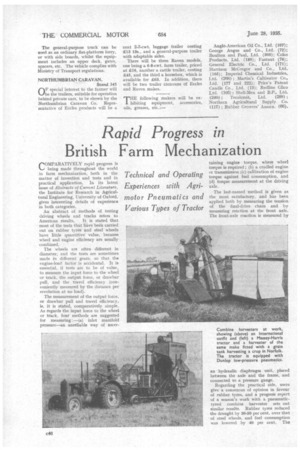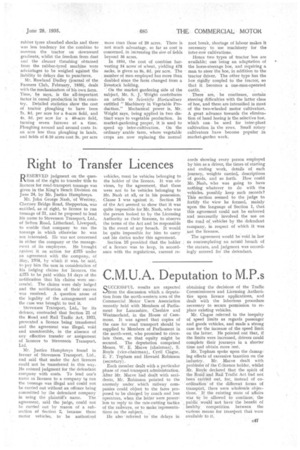Rapid Progress in British Farm Mechanization
Page 96

Page 97

If you've noticed an error in this article please click here to report it so we can fix it.
Technical and Operating Experiences with Agrimotor Pneumatics and Various Types of Tractor
COIVIPARATIVELY rapid progress is being made throughout the world in farm mechanization, both in the matter of invention and tests and in practical application. In its latest issue of Abstracts of Current Literature, the Institute for Research in Agricultural Engineering, University of Oxford, gives interesting details of experience in both categories.
An abstract of methods of testing driving wheels and tracks refers to American results. It is stated that most of the tests that have been carried out on rubber tyres and steel wheels have little quantitive value, because wheel and engine efficiency are usually combined.
The wheels are oftendifferent in diameter, and the tests are sometimes made in different gears, so that the engine-load factor is accidental. It is essential, if tests are to be of value, to measure the input force to the wheel or track, the output force, or drawbar pull, and the travel efficiency (conveniently measured by the distance per revolution at no load).
The measurement of the output force, or drawbar pull and travel efficiency, is. it is stated, comparatively simple. As regards the input force to the wheel or track, four methods are suggested for measuring :—(a) inlet manifold pressure—an unreliable way of ascer taming engine torque, where wheel torque is required ; (b) a cradled engine or transmission ;(c) calibration of engine torque against fuel consumption, and (d) torque measurement at the driving axle.
The last-named method is given as the most satisfactory, and has been applied both by measuring the tension of the final-drive chain and by measuring reaction at the front axle. The front-axle reaction is measured by
an •hydraulic diaphragm unit, placed between the axle and the frame, and connected to a pressure gauge.
Regarding the practical side, users give a consensus of opinion in favour of rubber tyres, and a progress report of a season's work with a pneumatictyred combine harvester sets out similar results. Rubber tyres reduced the draught by 30-50 per cent, over that
• of steel wheels, and fuel consumption was lowered by 40 per cent. The
rubber tyres absorbed shocks and there was less tendency for the combine to overrun the tractor on downward gradients, whilst the freedom from• dust and the cleaner thrashing obtained from the rubber-tyred machine were advantages to be weighed against. the liability to delays due to,punctures.
Mr. Rowland Dudley (journal of the Farmers. Club,' February, 1935), deals with the Mechanization of his Own farm. Time, • he says, is the all-important factor in cereal production in this country. Detailed statistics show the Cost of tractor ploughing • to have been 7s. 8d, per acre for a 6-acre field, and 4s. 3d. per acre for a 40-acre field, turning seven furrows at a time. Ploughing around and around costs 1s: an acre less than ploughing in lands, and fields of 6-10 acres cost 3s. per acre
more than those of 20 acres. There is not much advantage, so far as cost is concerned, in increasing the size of fields beyond 35 acres.
In 1934, the cost of combine harvesting 34 acres of wheat, yielding 478 sacks, is given as 9s. 64. per acre. The number of men employed has more than doubled since the farm changed from a lilies-Lock holding.
On the market gardening side of the subject, Mr. S. J. Wright contributes an article th Scionti fic Horitculture entitled " Machinery in Vegetable Production." Mechanical power is, Mr. Wright says, being applied in two distinct ways to vegetable production. In market-gardening proper, it is used to speed up inter-cultivation. On the ordinary arable farm, where vegetable crops are now replacing the normal root break, shortage of labour makes it necessary to use machinery for the inter-row cultivations.
Hence two types of tractor hoe are
available; one being an adaptation of • the horse-steerage hoe, and requiring a man to steer the hoe, in addition to the tractor driver. The other type has the hoe rigidly coupled to the tractor, so that it becomes a one-man-operated
outfit. . .
• There are, he continues, certain steering difficulties with the latter class of hoe, and these are intensified in most of the two-wheeled motor cultivators. A great advance towards the elimination of hand hoeing is the selective hoe, which can be used for inter-plant cultivation in the rows. Small rotary cultivators have become popular in market-garden work.




























































































































































